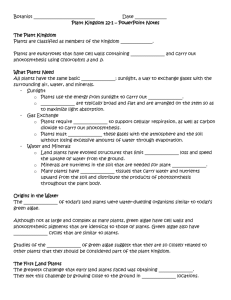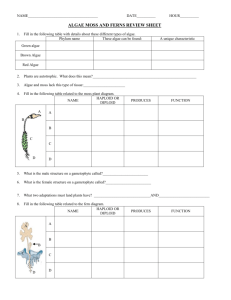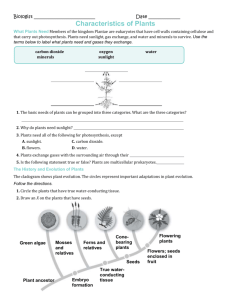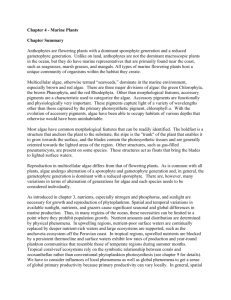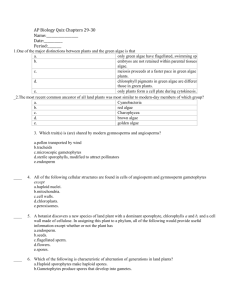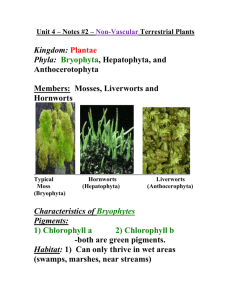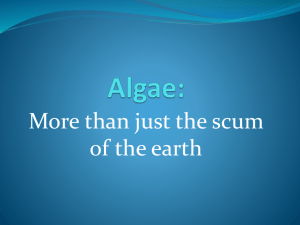Chapter 6
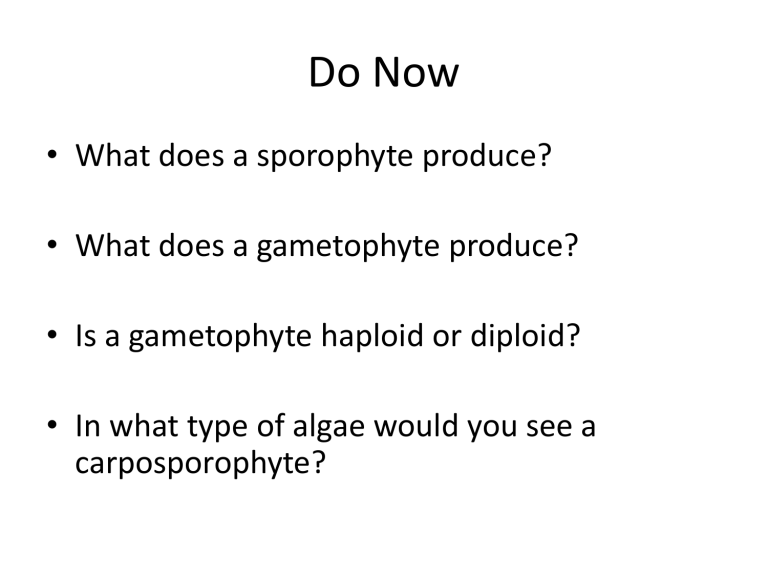
Do Now
• What does a sporophyte produce?
• What does a gametophyte produce?
• Is a gametophyte haploid or diploid?
• In what type of algae would you see a carposporophyte?
Review: Life Histories
• What algae have an alternation of (2) generations?
• What algae have an alternation of (3) generations?
• What algae have haploid dominant life histories?
• What algae have no alternation of generations?
Review: Life Histories
• If I am an algae and I have a carposporophyte phase in my life history what type of algae do I have to be?
• Is a carposporophyte diploid (2N) or hapolid
(1N)?
• What do carposporophytes produce through mitosis?
• Are carpospores diploid (2N) or haploid (1N)?
Review: Life History
• What does a gametophyte produce?
• Is a gametophyte diploid (2N) or haploid (1N)?
• Are gametes produced through mitosis or meiosis?
• Is a sporophyte diploid (2N) or haploid (1N)?
• What does a sporophyte produce?
• Are spores diploid (2N) or haploid (1N)?
• Are spores produced through mitosis or meiosis?
Review: Life History
• What are flagellated spores known as?
• What happens to the zygote right away in the haploid dominant life history?
PhD Scripps
• http://www.youtube.com/watch?v=CB2XlpD-
Ld4
Writing in Science
• At lease one page written
• Will be turned in today
• I will call you up to give you your test for test corrections
• Prompt: Explain why the algae are so significant to like on earth. What makes them so essential for life? What would happen if we removed all the algea from earth now that it is so developed?
What would you anticipate it affecting (if anything).
Do Now
• 1) do you think there are flowering plants in the marine environment?
• 2) Name 3 parts of a seaweed
• 3) What type of seaweed has fucoxanthin as a pigment?
Objective
• SWBAT: Identify the flowering plant representative groups of the marine environment
• Describe the economic importance of seaweeds
Chapter 6
Economic Importance
Importance
• Food Source
• Mariculture - farming of seaweeds
– China, Japan, Korea
• Phycocolloids - Gelatinous chemicals
– Used in food processing
– AlginMajor source is Kelp
– CarrageenanMajor source is Irish moss (Chonrus)
– AgarMain source is red algae
• Fertilizers, food additives in animal feeds, hospitals
Flowering plants
• 250,000 flowering plants
• Few marine
• Have true leaves, stems, and roots provided with special tissues to transport water nutrients and food
• Plantae
• Reproduction – dominant sporophyte (flower)
• Only the sea grasses are truly marine
Sea grasses
• Not really grasses
• Evolved from land plants
• Adaptations to marine environmentRhizomes
• Small inconspicuous flowers
• http://www.youtube.com/watch?v=XMhVJjm_RX c&feature=relmfu
• http://www.youtube.com/watch?v=aTmGB8YkQh
Y&feature=related
Salt- Marsh plants
• Cordgrasses - true members of the grass family
– Land plants that can tolerate salt
• Do not tolerate total submergence by seawater.
• Leaves are always partly exposed to air
• Salt glands on leaves
• Salt tolerant plants are known as halophytes
Mangroves
• http://www.youtube.com/watch?v=9SMM7x7qKE4
• http://www.youtube.com/watch?v=9SMM7x7qKE4
• How many species of magroves are there?
• Why are they so important to the estuarine food chain?
• How do they protect the shore? What do they protect the shore from?
Mangroves
• Count off by 3s
• 1) Seagrasses
• 2) Saltmarsh plants
• 3) Mangroves
Poster
• Outline the section in your poster
• On the back answer #2 critical thinking question
Announcement
• We will have a quiz on the reproduction cycles tomorrow
Exit Ticket
• Give three examples of the economic importance of seaweeds
• Are there a lot of marine flowering plant representatives?
• Which of the following are true members of the grass family: A) Seagrass B) Cordgrass C)
Both

